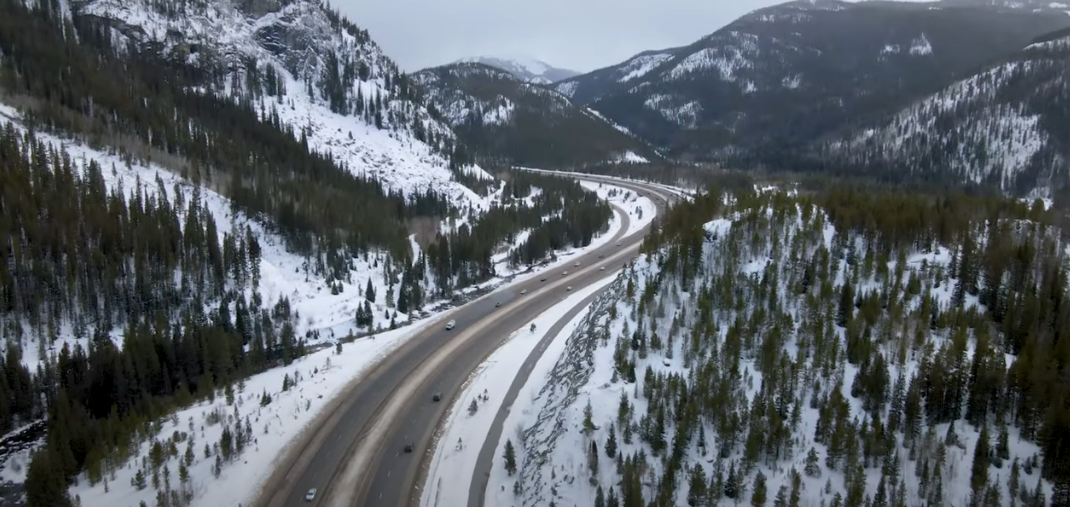CDOT Launches New - Winter Driving in the Wild - Video Series

Description: Press Play to View the - Winter Driving in the Wild - introduction video (Courtesy of Colorado Department of Transportation)

CDOT launches new "Winter Driving in the Wild" video series
Educational videos serve as entertaining reminders for safe winter driving
STATEWIDE — Today, CDOT’s Winter Wise campaign is launching “Winter Driving in the Wild,” an educational video series that will raise awareness of the laws, preparations and resources for safe and efficient winter driving. The series features the do’s and don’ts of Colorado winter driving through wildlife documentary-style mini-movies. “Winter Driving in the Wild” launches as CDOT prepares for winter travel, and the department hopes the series serves as a humorous and educational reminder of how to stay safe throughout winter.
The series includes videos about the Passenger Vehicle Traction Law, tire and snowplow safety, winter preparedness tips and a guide for winter driving resources. CDOT will release new editions of the series through winter.
“Motorists who are unprepared for winter road conditions create dangerous situations for themselves and everyone on the road, not to mention the extended delays we see from spinouts, slideoffs and crashes,” said Andrew Hogle, CDOT public information officer. “We’re excited to launch the ‘Winter Driving in the Wild” series to share these crucial messages and have some fun with Colorado drivers at the same time.”
Having adequate tires with proper tread depth is the first step motorists should take before choosing to drive on winter roads. Between October 2020 and April 2021, 262 passenger vehicle crashes were reported on the I-70 mountain corridor in addition to 91 non-crash emergency responses (mechanical issues, fires, spinouts/slideoffs). Many of these crashes, spinouts and slideoffs were due to poor quality tires.
Having adequate tires is not only safe; it’s also the law. Last winter, CDOT activated the Passenger Vehicle Traction Law 166 times on the I-70 mountain corridor alone. CDOT can implement the Passenger Vehicle Traction and Chain Laws on any state highway.
During a Passenger Vehicle Traction Law, all motorists are required to have one of the following:
- A 4WD or AWD vehicle and 3/16” tread depth
- Tires with a mud and snow designation (M+S icon) and 3/16” tread depth
- Winter tires (mountain-snowflake icon) and 3/16” tread depth
- Tires with an all-weather rating by the manufacturer and 3/16” tread depth
- Chains or an approved alternative traction device
CDOT conducted a Passenger Vehicle Traction Law survey in January 2020 that found that rental vehicles were the most compliant vehicle type at 95%, and out-of-state vehicles were the least compliant at 86%. The primary reason for noncompliance: insufficient tread. Download the Compliance Infographic here for a visual summary of the report.
“The Traction Law is activated for safety and efficiency purposes,” said Hogle. “If everyone on the road has adequate tires and tread, then we’ll see fewer crashes and reduce delay times. That’s the goal — we want every Colorado motorist to get home safely without causing closures or extended delays. These laws and guidelines help us ensure that.”
For the most up-to-date winter driving resources, information and tips, visit winter.codot.gov.
Whether you’re a native, a new resident or a tourist, driving in Colorado winter weather can be dangerous if you’re not prepared. As we enter the winter months, CDOT wants to remind all Colorado roadway users of the following tips to stay safe.
BEFORE YOU TRAVEL THIS WINTER:
- Have a plan. Prepare a winterized emergency vehicle kit. Always plan your route in advance and be sure to let someone know your route and ETA. Check road conditions at COtrip.org.
- Check your tires. It’s tire buying season! Make sure to check the air pressure in all tires, including your spare, and that your tires have good tread — at least 3/16”.
- Perform a safety check. Give your vehicle a tune-up before long trips. This includes getting an oil change if necessary, inspecting the battery, brakes and pads and wiper blades. Ensure you have a full tank of gas, and lastly, check your headlights, brake lights, turn signals, emergency flashers and interior lights.
- Know the laws. When weather conditions warrant, CDOT implements Passenger Vehicle Traction and Chain Laws. Head over to CDOT’s Traction & Chain Laws page for the most up-to-date laws.
WHILE YOU’RE ON THE ROAD:
- Drive for the conditions. Don’t drive faster than you can see ahead and don’t forget to turn on your headlights! If you’re stuck in a serious storm, do not leave your vehicle. Run the engine periodically and wait for help.
- Bow to the plow. It is illegal to pass a snowplow when it is operating its lights and operating in a tandem formation with one or more snowplows. Don’t crowd the plow, be sure to remain three to four car lengths behind snowplows.
STAY INFORMED:
Travelers are urged to “know before you go.” Gather information about weather forecasts and anticipated travel impacts and current road conditions prior to hitting the road. CDOT resources include:
- Road conditions and travel information: www.COtrip.org
- Sign up for project or travel alerts: bit.ly/COalerts
- See scheduled lane closures: codot.gov/travel/scheduled-
lane-closures.html - Connect with us on social media: Twitter @coloradodot and Facebook facebook.com/coloradodot
ABOUT WINTER WISE
CDOT’s Winter Wise campaign focuses on education, tools and resources to help keep drivers safe on Colorado’s winter roads. To learn more and view helpful tips for winter driving, visit winter.codot.gov. For specific information about I-70 and other highway travel conditions, motorists can call 511 or check COtrip.org. Additionally, drivers can check Twitter for up-to-date travel information via @ColoradoDOT. For more detailed information about the Traction and Passenger Vehicle Safety Laws, snowplow laws, safety stats and frequently asked questions, visit winter.codot.gov.
ABOUT CDOT
CDOT’s Whole System-Whole Safety program has one simple mission — to get everyone home safely. Our approximately 3,000 employees work tirelessly to reduce the rate and severity of crashes and improve the safety of all modes of transportation. The department manages more than 23,000 lane miles of highway, more than 3,000 bridges and 35 mountain passes. CDOT also manages grant partnerships with a range of agencies, including metropolitan planning organizations, local governments and airports. It also operates Bustang, the state-owned interregional express bus service. Gov. Jared Polis has charged CDOT to further build on the state’s intermodal mobility options.
Follow SECO News on Facebook.
Subscribe to the SECO News YouTube Channel.
Press releases Sponsor






.png)






.png)
.png)


.png)







